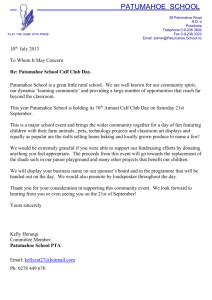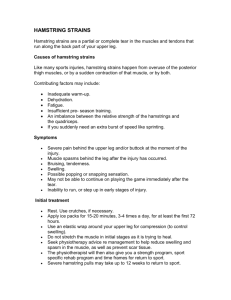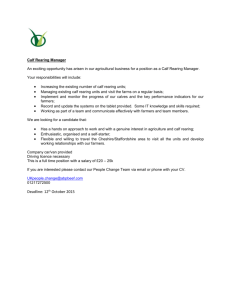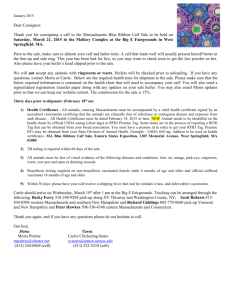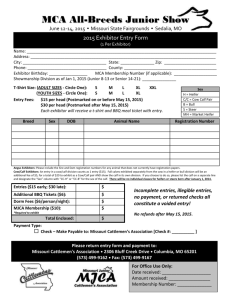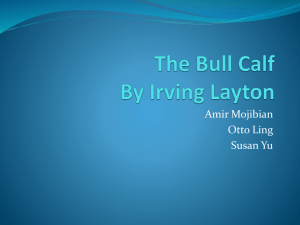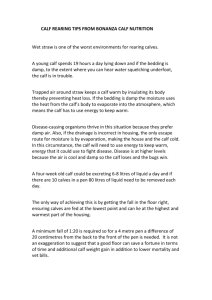File - TAC Distance Runners
advertisement
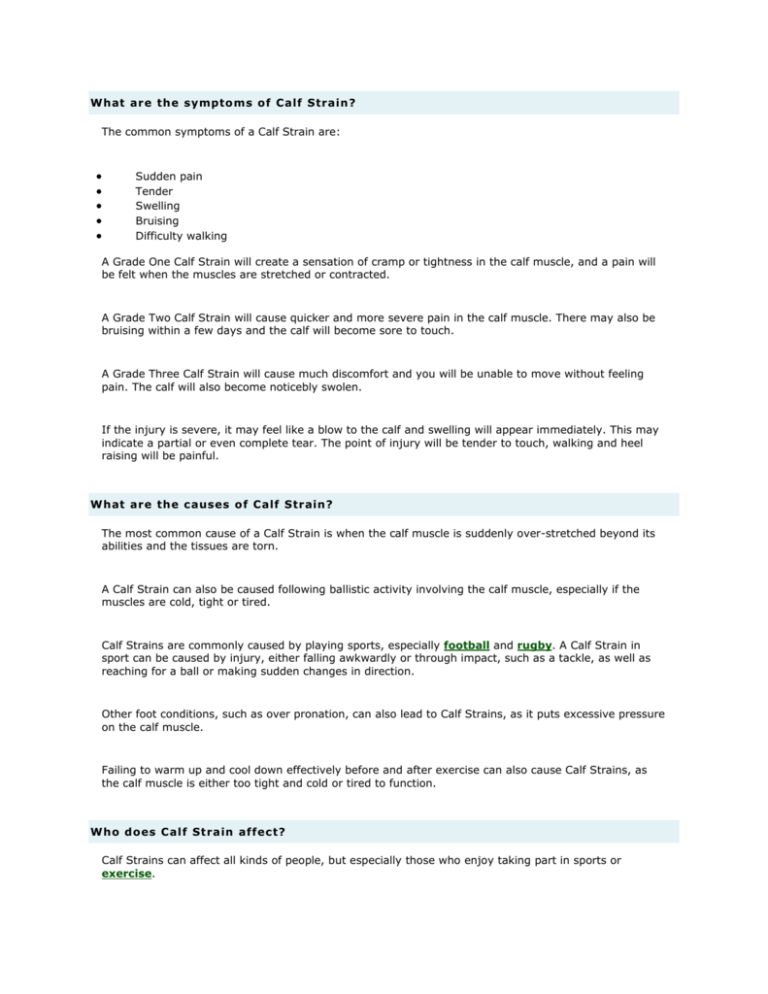
What are the sympto ms of Calf Strain? The common symptoms of a Calf Strain are: Sudden pain Tender Swelling Bruising Difficulty walking A Grade One Calf Strain will create a sensation of cramp or tightness in the calf muscle, and a pain will be felt when the muscles are stretched or contracted. A Grade Two Calf Strain will cause quicker and more severe pain in the calf muscle. There may also be bruising within a few days and the calf will become sore to touch. A Grade Three Calf Strain will cause much discomfort and you will be unable to move without feeling pain. The calf will also become noticebly swolen. If the injury is severe, it may feel like a blow to the calf and swelling will appear immediately. This may indicate a partial or even complete tear. The point of injury will be tender to touch, walking and heel raising will be painful. What are the c auses o f Calf Strain? The most common cause of a Calf Strain is when the calf muscle is suddenly over-stretched beyond its abilities and the tissues are torn. A Calf Strain can also be caused following ballistic activity involving the calf muscle, especially if the muscles are cold, tight or tired. Calf Strains are commonly caused by playing sports, especially football and rugby. A Calf Strain in sport can be caused by injury, either falling awkwardly or through impact, such as a tackle, as well as reaching for a ball or making sudden changes in direction. Other foot conditions, such as over pronation, can also lead to Calf Strains, as it puts excessive pressure on the calf muscle. Failing to warm up and cool down effectively before and after exercise can also cause Calf Strains, as the calf muscle is either too tight and cold or tired to function. Who does Calf Strain affec t? Calf Strains can affect all kinds of people, but especially those who enjoy taking part in sports or exercise. All the people who perform explosive movements with the calf, e.g. tennis players, high jumpers, long jumpers and sprinters, are all susceptible to Calf Strains. Rugby players and footballers also commonly suffer Calf Strains due to sudden outburst of speed, changes in direction and stretches for the ball (football) they make. What are the treatments fo r Calf Strain? Upon suffering a Calf Strain, you should immediately apply cold therapy to the calf, such as a cold wrap or pack . This will help to reduce swelling and relieve the pain. You should then rest the calf and elevate it, while compression could also help to limit swelling. It is recommended that you seek the medical advice of a healthcare professional to assess the Calf Strain and suggest treatments. Initially, crutches may be necessary in severe cases of Calf Strains to protect the calf muscle, but as soon as possible try and use the muscle as normally as possible to maintain movement. After a short period of time, treatment for a Calf Strain could include local soft tissue massages and calf stretching execises. What Exerc ises Are Good for This? Calf strengthening - heel raises Overview: This is a more advanced exercise to work your calf. Exercise guide: 1. Stand on the bottom step of your stairs facing the stairs. 2. Move back on the step and stand so that only the balls of your feet are left on the step with your heels hanging over the edge. 3. Slowly lower your heels towards the floor until you feel a gentle stretch in the back of your leg. 4. Then slowly raise up on to tip toes. 5. Try six repetitions with two sets to start with or even less if you feel that might be too much. Build up to 20 repetitions with four sets. Note: 1. Make sure your hips stay over your feet and ensure they do not sway forwards and backwards during the exercise. 2. Make sure you do the movement slowly and work through a full range. 3. Don’t do too many and overload your calves too soon, otherwise a stiff calf can be very sore in the next few days. Other exercises What are the sympto ms of Hamstring Strain? The common symptoms of a Hamstring Strain are: Pain Bruising Tightness Stiffness The symptoms of a Hamstring Strain maybe gradual and at the back of the thigh if the Hamstring Strain was caused by an overuse injury. The bruising of a Hamstring Strain will only be present if it occured from a direct blow which may track downwards towards the back of the knee over time. What are the c auses o f Hamstring Strain? The cause of a Hamstring Strain is from a direct blow to the back of the thigh or from overstretching. With an acute Hamstring Strain, the hamstring muscles or tendons may tear as a result of a sudden overstretching. This can be caused during a sudden sprint or if there is a direct blow to the hamstrings when the muscles are contracted. A Hamstring Strain is usually caused by a sporting injury, especially football, by overstretching for a ball, impact from a tackle, sudden change in direction or from sprinting. Another cause of a Hamstring Strain is from an overuse injury. A Hamstring Strain occurs if the muscles are cold, tight, fatigued or weak and then strained if over worked. Who does Hamstring Strain affect? Hamstring Sprains are common in people who enjoy playing sports, such as sprinting and football. What are the treatments for Hamstring Strain? The treatments for a Hamstring Strain consist of treating the pain and swelling, and then taking preventative measures for a Hamstring Strain. Upon suffering a Hamstring Strain, you should apply a cold wrap or pack, such as the Vulkan Instant Ice Pack, to reduce swelling and relieve pain. You should also rest the hamstring and apply compression to limit swelling and bruising. Once the pain and swelling of a Hamstring Strain has disappeared, you should carry out stretching and strengthening exercises listed for a Hamstring Strain to regain mobility and build up strength. It is always important to seek medical advice from a healthcare professional with a Hamstring Strain. You can see a Physiotherapist for manual therapy, electrotherapy, stretching and strengthening rehabilitation programme. Additional treatment tips: Always warm up and cool down, and stretch thoroughly before and after taking part in any physical or sporting activity in order to reduce the risk of injury Make sure you spend time strengthening the groin and thigh muscles to improve your performance and reduce the risk of injury Try to keep your body weight within normal limits for your height as excessive body weight can aggravate hip pain caused by conditions like arthritis What Exerc ises Are Good for This? Hamstring stretch Overview: To ensure a fully functional hamstring and pelvis, it is important to have a flexible hamstring muscle. Exercise guide: 1. Stand with one leg on a stool or bench. 2. Keep both legs straight and your hips and pelvis square to the stool. 3. Turn your standing leg inwards by pivoting on your toes. 4. This increases the stretch in your opposite hamstring. 5. Hold for 30 seconds and do three sets. Note: To progress the exercise, use a slightly higher stool. Knee range of movement Overview: After a knee injury it is important to get a full range of movement. Exercise guide: 1. Sit on a slippery floor (e.g. wooden floor) with a sock on your affected leg. 2. Gently slide your foot on the floor towards you by bending your knee. 3. Gently work the range and gradually try and pull your heel towards you. 4. Try six to eight repetitions and two sets of exercises. Note: Make sure you build the range up gradually. If your knee swells up during or after the exercise, you are either working too hard or too fast, or it is too soon to try the exercise. Knee range of movement a Knee range of movement b
